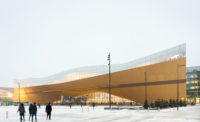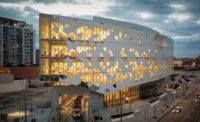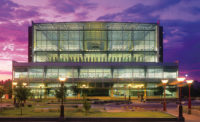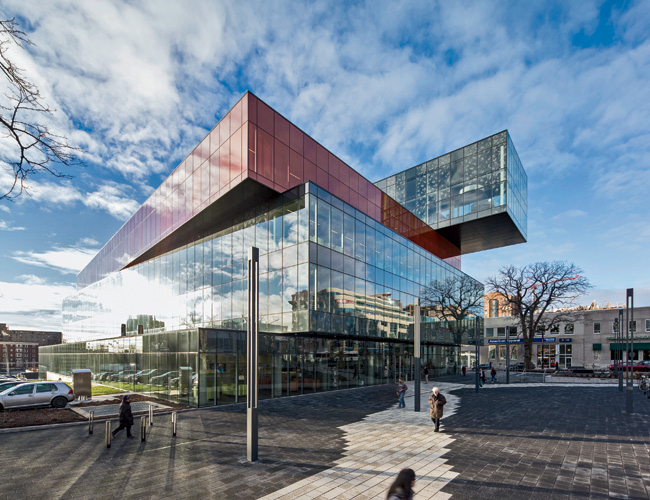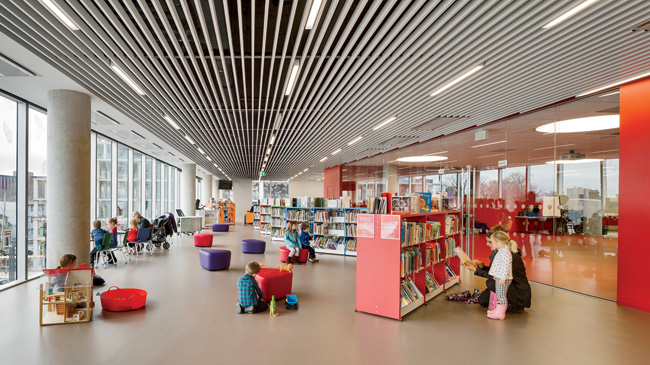Halifax Central Library
It All Stacks Up: A vibrant new library emphasizes connections within its walls and out to the city, fast becoming a much-needed community hub.


























For a little city, Halifax, the capital of the province of Nova Scotia, has no shortage of bragging rights. The biggest urban area in Atlantic Canada with a large and strategically located harbor, it is a major economic center for the region—fueled by port commerce, shipbuilding, government services, and higher education, among other industries. Nevertheless, in recent years, there has been a dearth of civic investment in this city of 400,000. So the opening in December of the new Halifax Central Library, a syncopated stack of glass boxes designed by Danish firm Schmidt Hammer Lassen (SHL), with Fowler Bauld & Mitchell (FBM) as executive architects, has been a big deal for the people here.
The 130,000-square-foot building reads as an assemblage of five volumes atop one another, each slightly cranked on a bias. Shaped by public input, the design also responds to its context. Rather than bringing the library right up to the edge of Spring Garden Road—a main shopping thoroughfare—the architects pushed it back, creating a public plaza and aligning the main facade with Dalhousie University's 1908 academic building next door. Then they pulled out the top floor as a cantilever, which nods to Halifax's maritime heritage by pointing to Citadel Hill and its historic fort to the north, with the volume's other end oriented toward the harbor, to the south. The twisting of the boxes is informed by the adjacent Queen Street and a pedestrian path. Both routes run on a diagonal, and their meeting point, if they continued, would be at the site. “Many see the building as referring to a stack of books,” says Morten Schmidt, founding partner of SHL. “It's a good reference, but the form has more to do with the urban grid and these crossed lines.”
The building, which is targeting LEED Gold, employs green roofs, rainwater harvesting, and a heat-recovery system in combination with chilled beams and slabs. By making a thermally tight envelope with super-insulated glass spandrel panels, the architects were able to use vision glass for 47 percent of the curtain wall, connecting the inside to the active street life, points out FBM president George Cotaras. The glazing creates a coherent surface across the library, which is punctuated by an orange volume colored by a ceramic dot frit. Abundant daylight floods in from a skylight atop the fourth level and through the north and south elevations down into a dramatic atrium—spanned by zigzagging stairs—that visually connects the various programmed spaces. With this transparency, light, and clear circulation and sight lines, says Schmidt, “We brought the same approach we use for projects in Scandinavia. We call it democratic architecture: creating a sense of openness, inviting everyone into the building and letting them feel they own it.”
With the trend of libraries' functioning as community centers as well as places of scholarship, the Halifax Central Library has a range of facilities—from cafés to recording studios, learning labs, and booth-like pods nestled among the book shelves. And it offers everything from cooking classes to 3-D printing and English as a Second Language workshops.
On a bright January morning, the library buzzed: toddlers and caregivers came for a drop-in, students camped out with laptops and coffee, and a group of seniors from nearby Faith Tabernacle Church rested in the lobby's reading lounge. English teacher Sarah MacVicar had brought her junior high class from Musquodoboit Harbour, 30 miles away. Remarking that the kids did not often get to the city, she said she brought them “hoping to open their minds to what can be offered at a library.” Clean-lined and welcoming, the building combines a lot of program in one cohesive package. And with a strong sense of connectedness, both through the interiors and to the surrounding city, it has quickly filled a void as a vital community hub. “It's not just a place you go to read books and get literacy,” points out Schmidt. “It's where you can use your hands, engage with art, music—all these things that are so important for a modern human being.”
|
Halifax Central Library Schmidt Hammer Lassen Architects Stop Motion Video of Construction |
People
Formal name of building:
Location:
Completion Date:
Gross square footage:
Total construction cost:
Client:
Architect:
Architects and Prime Consultant
Personnel in architect's firm who should receive special credit: Chris Hardie, Architect, ARB, RIBA, Partner, schmidt hammer lassen architects George Cotaras, Architect, NSAA, OAA, MRAIC, President & General Manager Fowler Bauld & Mitchell Ltd. Wayne Duncan, B.Arch., Vice President, Fowler Bauld & Mitchell Ltd. Interior designer: schmidt hammer lassen architects and Fowler Bauld & Mitchell Ltd.
Engineers:
Consultant(s):
Photographer: Size: 130,000 square feet Project Cost: $46 million Construction Cost: $35 million |
Products
Structure
Steel:
Cladding:
Roofing:
Insulation:
Doors & Windows:
Elevators:
Interior Finishes:
Site Work:
Mechanical Electrical A/V: |


